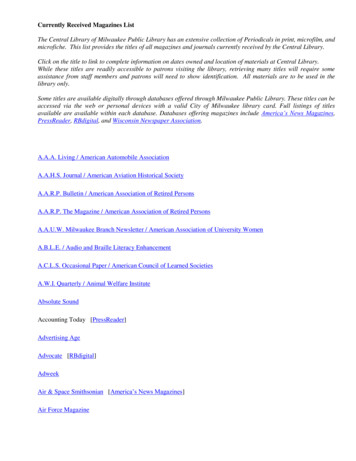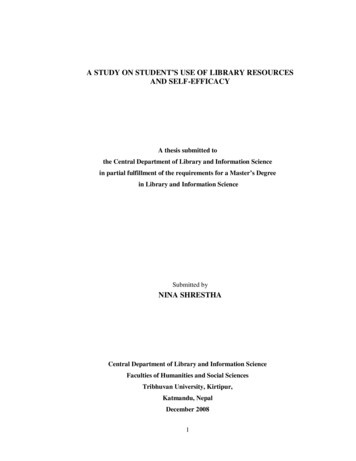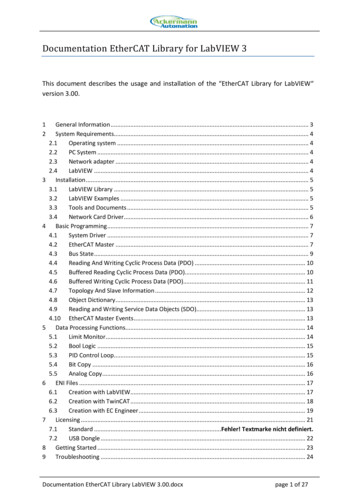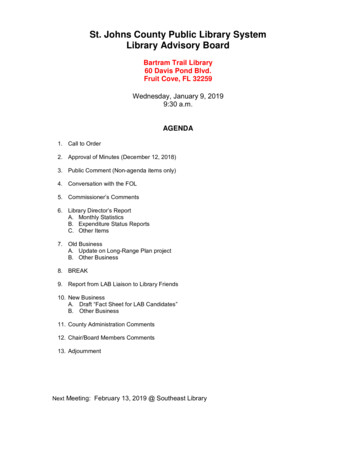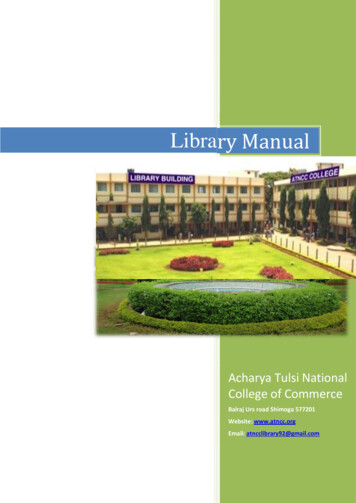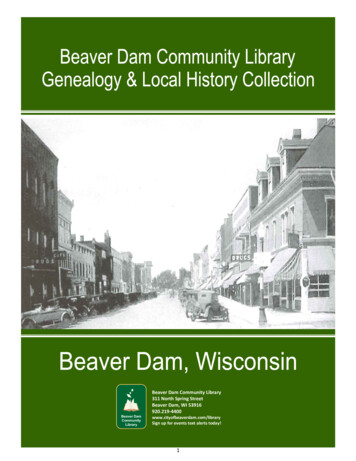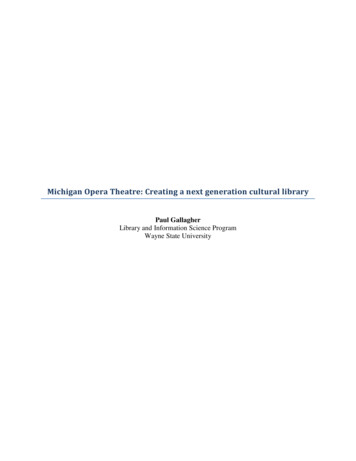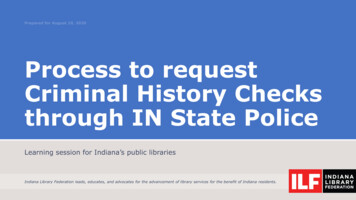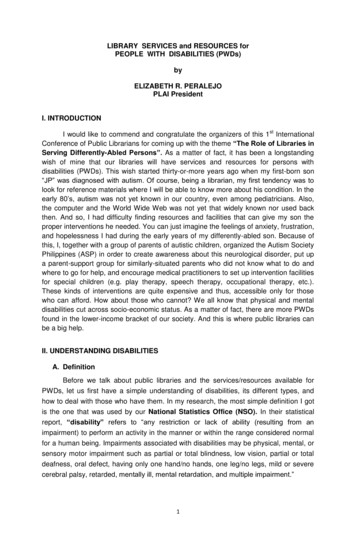
Transcription
LIBRARY SERVICES and RESOURCES forPEOPLE WITH DISABILITIES (PWDs)byELIZABETH R. PERALEJOPLAI PresidentI. INTRODUCTIONI would like to commend and congratulate the organizers of this 1 st InternationalConference of Public Librarians for coming up with the theme “The Role of Libraries inServing Differently-Abled Persons”. As a matter of fact, it has been a longstandingwish of mine that our libraries will have services and resources for persons withdisabilities (PWDs). This wish started thirty-or-more years ago when my first-born son“JP” was diagnosed with autism. Of course, being a librarian, my first tendency was tolook for reference materials where I will be able to know more about his condition. In theearly 80’s, autism was not yet known in our country, even among pediatricians. Also,the computer and the World Wide Web was not yet that widely known nor used backthen. And so, I had difficulty finding resources and facilities that can give my son theproper interventions he needed. You can just imagine the feelings of anxiety, frustration,and hopelessness I had during the early years of my differently-abled son. Because ofthis, I, together with a group of parents of autistic children, organized the Autism SocietyPhilippines (ASP) in order to create awareness about this neurological disorder, put upa parent-support group for similarly-situated parents who did not know what to do andwhere to go for help, and encourage medical practitioners to set up intervention facilitiesfor special children (e.g. play therapy, speech therapy, occupational therapy, etc.).These kinds of interventions are quite expensive and thus, accessible only for thosewho can afford. How about those who cannot? We all know that physical and mentaldisabilities cut across socio-economic status. As a matter of fact, there are more PWDsfound in the lower-income bracket of our society. And this is where public libraries canbe a big help.II. UNDERSTANDING DISABILITIESA. DefinitionBefore we talk about public libraries and the services/resources available forPWDs, let us first have a simple understanding of disabilities, its different types, andhow to deal with those who have them. In my research, the most simple definition I gotis the one that was used by our National Statistics Office (NSO). In their statisticalreport, “disability” refers to “any restriction or lack of ability (resulting from animpairment) to perform an activity in the manner or within the range considered normalfor a human being. Impairments associated with disabilities may be physical, mental, orsensory motor impairment such as partial or total blindness, low vision, partial or totaldeafness, oral defect, having only one hand/no hands, one leg/no legs, mild or severecerebral palsy, retarded, mentally ill, mental retardation, and multiple impairment.”1
Similarly, the World Health Organization defines “disability” as the consequenceof an impairment that may be physical, cognitive, mental, sensory, emotional,developmental, or some combination of these. A disability may be present from birth, oroccur during a person's lifetime. Disabilities is an umbrella term, covering impairments,activity limitations, and participation restrictions. An impairment is a problem in bodyfunction or structure; an activity limitation is a difficulty encountered by an individual inexecuting a task or action; while a participation restriction is a problem experienced byan individual in involvement in life situations. Thus, disability is a complex phenomenon,reflecting an interaction between features of a person’s body and features of the societyin which he or she lives.]B. TheoryThe International Classification of Functioning, Disability and Health (ICF), produced bythe World Health Organization, distinguishes between body functions (physiological orpsychological, such as vision) and body structures (anatomical parts, such as the eyeand related structures). In consonance with disability scholars, the ICF states that avariety of conceptual models has been proposed to understand and explain disabilityand functioning, which it seeks to integrate. These models include the following:1. The medical modelThe medical model is presented as viewing disability as a problem of the person,directly caused by disease, trauma, or other health condition which therefore requiressustained medical care provided in the form of individual treatment by professionals. Inthe medical model, management of the disability is aimed at a "cure," or the individual’sadjustment and behavioral change that would lead to an "almost-cure" or effective cure.In the medical model, medical care is viewed as the main issue, and at the politicallevel, the principal response is that of modifying or reforming healthcare policy.2. The social modelThe social model of disability sees the issue of "disability" as a socially createdproblem and a matter of the full integration of individuals into society. In this model,disability is not an attribute of an individual, but rather a complex collection ofconditions, many of which are created by the social environment. Hence, themanagement of the problem requires social action and it is the collective responsibilityof society at large to make the environmental modifications necessary for the fullparticipation of people with disabilities in all areas of social life.3. The spectrum modelThe spectrum model refers to the range of visibility, audibility and sensibility underwhich people function. The model asserts that disability does not necessarily meanreduced spectrum of operations. Rather, disability is often defined according tothresholds set on a continuum of disability.2
4. The moral modelThe moral model refers to the attitude that people are morally responsible for their owndisability. For example disability may be seen as a result of bad actions of parentsif congenital, or as a result of practicing witchcraft if not. Echoes of this can be seen inthe doctrine of karma in Indian religions. It also includes notions that a disability gives aperson "special abilities to perceive, reflect, transcend, be spiritual".5. The consumer modelThe consumer model of disability is based upon the “rights-based" model and claimsthat people with disabilities should have equal rights and access to products, goods andservices offered by businesses. The consumer model extends the rights-based modelby proposing that businesses, not only accommodate customers with disabilities underthe requirements of legislation, but that businesses actively seek, market to, welcomeand fully engage people with disabilities in all aspects of business service activities. Themodel suggests that all business operations, for example websites, policies andprocedures, mission statements, emergency plans, programs and services, shouldintegrate access and inclusion practices. Furthermore, these access and inclusionpractices should be based on established customer service access and inclusionstandards that embrace and support the active engagement of people of all abilities inbusiness offerings.C. Types of disabilityThe degree of disability may range from mild to moderate, severe, or profound. Aperson may also have multiple disabilities. Conditions causing disability are classified bythe medical community as: inherited - genetically transmitted; congenital - caused by a mother's infection or other disease duringpregnancy, embryonic or fetal developmental irregularities, or by injuryduring or soon after birth; acquired - such as conditions caused by illness or injury; or of unknown origin.Types of disability may also be categorized in the following way:1. Physical disabilityAny impairment which limits the physical function of limbs, fine bones, or grossmotor ability is a physical impairment, not yet a physical disability. The Social Model ofDisability defines physical disability as manifest when an impairment meets a nonuniversal design or program, e.g. a person who cannot climb stairs may have a physicalimpairment of the knees when putting stress on them from an elevated position such aswith climbing or descending stairs. If an elevator was provided, or a building hadservices on the first floor, this impairment would not become a disability.3
2. Sensory disabilitySensory disability is impairment of one of the senses. The term is used primarilyto refer to vision and hearing impairment, but other senses can be impaired.3. Vision impairmentVision impairment (or "visual impairment") is vision loss (of a person) to such adegree as to qualify as an additional support need through a significant limitationof visual capability resulting from either disease, trauma, or congenital or degenerativeconditions that cannot be corrected by conventional means, such as refractivecorrection, medication, or surgery.4. Hearing impairmentHearing impairment or hard of hearing or deafness refers to conditions in whichindividuals are fully or partially unable to detect or perceive at least some frequencies ofsound which can typically be heard by most people. Mild hearing loss may sometimesnot be considered a disability.5. Olfactory and gustatory impairmentImpairment of the sense of smell and taste are commonly associated with agingbut can also occur in younger people due to a wide variety of causes. There are variousolfactory disorders such as the following: Anosmia – inability to smell Dysosmia – things smell different than they should Hyperosmia – an abnormally acute sense of smell. Hyposmia – decreased ability to smell Olfactory Reference Syndrome – psychological disorder which causespatients to imagine they have strong body odor Parosmia – things smell worse than they should Phantosmia – "hallucinated smell", often unpleasant in nature6. Somatosensory impairmentInsensitivity to stimuli such as touch, heat, cold, and pain are often an adjunct toa more general physical impairment involving neural pathways and is very commonlyassociated with paralysis (in which the motor neural circuits are also affected).7. Intellectual disabilityIntellectual disability is a broad concept that ranges from mental retardation tocognitive deficits too mild or too specific (as in specific learning disability) to qualify asmental retardation. Intellectual disabilities may appear at any age. Mental retardation isa subtype of intellectual disability.8. Mental health and emotional disabilitiesA mental disorder or mental illness is a psychological or behavioral patterngenerally associated with subjective distress or disability that occurs in an individual,4
and perceived by the majority of society as being outside of normal development orcultural expectations.9. Developmental disabilityDevelopmental disability is any disability that results in problems with growth anddevelopment.10. Nonvisible disabilitiesSeveral chronic disorders, such as diabetes, asthma, inflammatory boweldisease or epilepsy, would be counted as nonvisible disabilities, as opposed todisabilities which are clearly visible, such as those requiring the use of a wheelchair.D. Communicating DisabilityIn the course of my research, I came across a brochure entitled “CommunicatingDisability” which contains communication protocols on the way we call and refer toPWDs. Included are words to use which organization of and for persons with disabilitieshave recommended when referring to PWDs in the production of communicationmaterials - be it in oral, written, or electronic format (e.g. PWDs instead ofdisabled/differently-abled, hearing-impaired instead of deaf mute, persons with DownSyndrome instead of Mongoloid, etc.). Many people would rather be referred to as aperson with a disability instead of handicapped. "Cerebral Palsy: A Guide for Care" atthe University of Delaware offers the following guidelines.“Impairment” is the correct term to use to define a deviation from normal, such asnot being able to make a muscle move or not being able to control an unwantedmovement. “Disability” is the term used to define a restriction in the ability to perform anormal activity of daily living which someone of the same age is able to perform. Forexample, a three-year-old child who is not able to walk has a disability because anormal three-year-old can walk independently. “Handicap” is the term used to describea child or adult who, because of the disability, is unable to achieve the normal role insociety commensurate with his age and socio-cultural milieu. As an example, a sixteenyear-old who is unable to prepare his own meal or care for his own toileting or hygieneneeds is handicapped. On the other hand, a sixteen-year-old who can walk only with theassistance of crutches but who attends a regular school and is fully independent inactivities of daily living is disabled but not handicapped. All disabled people areimpaired, and all handicapped people are disabled, but a person can be impairedand not necessarily be disabled, and a person can be disabled without beinghandicapped.The American Psychological Association style guide states that, whenidentifying a person with an impairment, the person's name or pronoun should comefirst, and descriptions of the impairment/disability should be used so that the impairmentis identified, but is not modifying the person. Improper examples are "a borderline",5
"a blind person", or "an autistic boy"; more acceptable terminology includes "a womanwith Down syndrome" or "a man who has schizophrenia". It also states that a person'sadaptive equipment should be described functionally as something that assists aperson, not as something that limits a person, for example, "a woman who uses awheelchair" rather than "a woman confined to a wheelchair."The brochure on “Communicating Disability” also contains basic guidelines inimproving communications about PWDs, and these are as follows :1. Acknowledge the natural curiosity and occasional awkwardness that maydevelop in social situations involving persons with and without disabilities.Where appropriate, provide positive examples in which such curiosity issatisfied and in which awkwardness is lessened.2. Avoid presenting people with disabilities as dependent or pitiful. Otherstereotypes to be avoided include presenting people as inherently saintly,gratuitously dangerous, or uniquely endowed with a special skill due todisability.3. Consider carefully the words used to describe or characterize individuals withdisabilities. Recognize and avoid phrases that may demean these individuals(e.g. blind as a bat, deaf and dumb).4. Present the achievements and difficulties of people with disabilities in waysthat do not overemphasize the impairment or exaggerate or emotionalize thesituation. For example, in news stories and documentary reports, the fact of aperson’s disability should be reported only when it is directly relevant.III. STATUS OF LIBRARY SERVICES FOR PWDs IN THE COUNTRYIn my visit to several libraries all over the country, I have not yet come across anylibrary (whether public or private) that give direct services nor resources to people withdisabilities. We all know or have heard about the Section for the Blind at the NationalLibrary whose librarian who is blind is one of the speakers in this conference. I alsolearned that the National Library has donated Braille materials to 6 provincial libraries, 6city libraries, 3 municipal libraries, and 1 barangay library in the various parts of thecountry. But these materials would cater only to the blind or the visually-impaired. Howabout the other forms of disabilities?When I went to the National Council on Disability Affairs (NCDA), the governmentagency mandated to formulate policies on disability and act as an over-all coordinatingand monitoring body that would rationalize the functions of government agencies andprivate entities related to the prevention of the causes of disability, I was told by itslibrarian that there is no data nor statistics which will show what and how many amongthese agencies or entities have libraries with services and resources for PWDs. But Ihave a feeling that if ever there is, there could only be a few, and mostly, they are forthe parents or relatives of PWDs, not for the PWDs themselves. For example, thelibrary of Autism Society Philippines which we put up. In that library, we were able toacquire a number of print and non-print materials (mostly cassette tapes and videos)and lend them to members or anyone who are interested to know more about ‘autism’,but not to the children/people with autism.6
I also learned from the librarian that the Council has been entering into aMemorandum of Agreement with libraries and other institutions who are interested toacquire reading materials for and about PWDs and are willing to promote their use intheir libraries. So far, the Council has signed a MOA with 27 libraries/universities, mostlyfound in Metro Manila. They also give referrals to institutions and agencies as well asprovide speakers on disability-related issues. And so, if you are interested, you can getin touch with the NCDA librarian, Mrs. Ermelita Miguel, at erme.miguel@gmail.comor at tel. no. 951-5013.IV. BEST PRACTICES FOR PWDs AMONG LIBRARIES ABROADA. New Jersey State Library Talking Book & Braille Center (TBBC)The NJSL-TBBC is a regional library of the National Library Service for the Blindand Physically Handicapped (NLS), a division of the U.S. Library of Congress. The NewJersey State Library is affiliated with Thomas Edison State College. The services of theNew Jersey State Library Talking Book & Braille Center (TBBC) are available to all NewJersey residents of any age whose ability to read is affected by a vision impairment, aphysical impairment or a reading disability. This includes anyone who cannot readstandard print or who cannot hold a book or turn the pages of a book. The Centerprovides books in Braille, cassette and digital formats (e-books). TBBC’s collection hasmore than 60,000 book titles and 76 periodicals available. Machines for playing therecorded materials are available on loan.B. National Lekotek Center, United StatesThe National Lekotek Center is a non-profit organization that provides an array ofservices to improve the lives of children with special needs through the utilization of toysand play. Lekotek Centers offer therapeutic play-based family sessions for families ofchildren with disabilities structured to help children learn, develop and thrive in a worldthat presents them with many unique and complex challenges. TOYS and PLAY are thevehicles used to provide children with an understanding of and an ability to relate to theworld around them. PLAY is also utilized to increase interactions within the family,especially between siblings, and the community as a whole.Nationally, Lekotek libraries contain over 50,000 toys that Family PlaySpecialists have analyzed and cataloged for families. Families receive toyrecommendations from the play specialists, who are knowledgeable about traditionaland specially-adapted toys. They are also experienced in adapting toys and modifyingplay to ensure optimal access and success.The toy lending concept further provides parents with toys and games that arematched to their child’s skills and interests. It also gives them the ability to test out toysto see what skills their children have mastered and what areas they need to focus on.Lekotek keeps track of the families’ loans. This can assist in identifying a pattern ofinterest and play and open discussions about stages of development. Toys can berevisited for future skill building opportunities. This service greatly simplifies the entireplay process and provides parents with examples and ideas of the types of toys theymay decide to purchase for their child in the future.7
C. Calgary Public Library Diversity Services, CanadaThe Calgary Public Library in Canada offers a wide range of specializedmaterials, facilities, services and programs to Calgarians of any age with visual orhearing impairments, the homebound, and persons with disabilities. Special Services’customers enjoy a growing and diverse collection that includes the latest bestseller andadaptive technology resources. Special services being offered are as follows:1. Homebound Readers’ ProgramThe Homebound Readers’ Program provides library service to customers whoare unable to visit the Library due to health or mobility issues. Volunteers will bematched with a customer to ensure their choice of material is delivered to their home.Volunteers help to select, deliver and exchange materials on behalf of homeboundcustomers.2. Adaptative Technology ALEX (Accessible Library Experience): Combines computer hardware andsoftware features into a fully integrated workstation that allows anyone to explorethe Internet, use e-mail, prepare business presentations or write term papers.Priority in using the ALEX workstation equipment is given to people who requirethe specialized technology. Motorized Furniture: Customers can adjust the workstation to their specificphysical needs. It is wide enough to accommodate wheelchairs of any size andthe 19 inch screen monitor can be pulled forward on a sliding platform. Different Keyboards: Adjustable touch-sensitivity and size of characters make itpossible for anyone to use a computer. Head Mouse and Switch: Allowing the possibility for people with controlled headmovement and lightweight tapping touch to use a computer with a visualonscreen keyboard. Screen Magnification Software: Increases the size of text on the computerscreen. Screen Reader Software: Reads aloud the content of the computer screen. Braille Printer: Changes computer screen content into a paper documentembossed in Braille. Optical Character Recognition Scanner: Information that is only available in printcan be scanned into the computer, displayed and spoken aloud by the screenreader software, therefore, text becomes accessible to people with printdisabilities. Word Prediction Software: Assists in preparing written documents by signalingspelling errors. It also provides complete word suggestions with audio support tomake reading, writing and editing of documents easier for people with learningdisabilities, literacy challenges or with English as a Second Language. Computer Operation by Voice: Using a microphone and headset, customers caninstruct the computer to create documents, send and receive e-mail and explorethe Internet.8
3. In-home Computer HelpThis one–on-one coaching session is offered at the customer’s home andis intended to help customers who are unable to visit the Library due to health ormobility concerns. The program offers training in the use of the internet, e-mail, andMicrosoft Office Software in the luxury of your own home.4. Closed Circuit Televisions (CCTVs)A CCTV permits readers to enlarge and enhance printed text or photos.5. Hand-held magnifiersMagnifying glasses for in-library users are available in most library branches anddepartments.6. Reading MachineA Kurzweil Reader scans print and reads it aloud.7. Text Telephones (TTYs)This system provides persons who are deaf or hard-of-hearing access to a phonesystem, by enabling them to type or read their messages over phone lines.D. San Francisco Public Library Accessibility Services , California, USA1. Resource Collection for Learning DifferencesSan Francisco's Main Library is the first public library in the United States to haveservices that singularly focus on learning differences. The Resource Collection forLearning Differences was established in 1993 with a commitment of support andguidance from the Roberts Foundation and Schwab Learning, a service of the Charlesand Helen Schwab Foundation. It provides extensive information for adults and childrenwith dyslexia, attention disorders and other learning differences and also their families,friends and professionals.2. Books by MailThis free service is offered to any resident of San Francisco whose use of theLibrary's facilities and resources is affected by permanent or long-term disability. Thelibrary will send as many books that fit into a large, reusable canvas mailbag. Everythingwill be sent via the US Postal Service to the home address of the borrower in reusablecanvas mailbags, with a pre-addressed and pre-paid return mailing card enclosed eachtime. When the borrower is ready to return the materials to the Library, the mailbag canbe given to the mail carrier or request someone to take it to a post office. Mailbags mayalso be returned to any SFPL branch during open hours or -- if they fit -- deposited inbook drops during closed hours. If materials are kept beyond the due date, the borrower9
is responsible for paying late fines. He/she is also responsible for replacing or paying forlost or damaged material.3. BARD (Braille and Audio Reading Download)The BARD offers downloadable digital audio books and magazines to eligibleNLS patrons. There are more than 20,000 digital books and over 40 magazinesavailable for download, with new titles being added regularly. BARD is available twentyfour hours a day, seven days a week, making service faster and more convenient thantraditional mail delivery.The following are needed to download the audio books: a computer with highspeed Internet access, an active email address, a digital player issued from an NLSregional library (or a third-party player can be purchased), the ability to unzip thedownloaded files and move them to either an empty cartridge (available for purchase) orto a USB flash drive (thumb drive) that has at least one gigabyte (1 GB) of storage.For digital players, the NLS digital Talking Book player has been preprogrammed to play downloaded BARD audio books. Due to digital rights managementrestrictions, BARD digital books will not play on any computer or MP3 player. However.some personal “third-party” players are compatible with NLS downloadable books. Todownload and play BARD books, one need to ask the manufacturer to authorize his/herplayer.4. Assistive Technologya. Accessibility ToolkitsAssistive Devices for People who are Blind or have Vision Disabilities :"Ergotouch" 2X hand-held magnifier. This is an economically priced andeffective magnifying glass.Magnifying sheet - 8.5 X 11.The size of this magnifier makes it useful forviewing illustrations, maps, etc.Signature guide. When placed on a sheet where people need to signtheir name, this simple tool makes it easier for users to write in the correct location.Page writing guide / reading guide. Standard line spacing makes thisuseful for people filling out print forms.18-inch Braille Large Print Ruler.This simple desk tool has universallyaccessible design.10
Sanford 20/20 pen.The unscented ink from these inexpensive bold pensdoesn’t bleed through paper. Bold lines are easier for people with low vision to read.Assistive Devices for People who have Dexterity Disabilities :Roberts Book Holder. Accommodates books and magazines of variedsizes and weights.Pencil Grip (for children or adults with smaller hands) / Pencil GripJumbo (for adults with larger hands). Ergo Pencil Grips provide greater comfort andcontrol for both right and left handed users, especially those with rheumatoid arthritis orcarpal tunnel syndrome. Fit on most any pencil or pen.Assistive Devices for People who are Hard of Hearing :Pocketalker Ultra Amplifier with Neckloop. This small personal amplifier,for one-on-one communications, can be used at a service desk, when walking with aperson to the stacks, or in a public computer class or program. The neckloop is used bypeople who have personal hearing aids.Headphones. Used with the Pocketalker by people who don’t havehearing aids.Headphone Disposable Covers. Made of sheer, medical grade poly,these should be replaced after each use.b. Braille Display and EmbosserThis device allows users to read in braille what isdisplayed on a computer screen or print such informationin braille.11
c. Computer Workstations (with Assistive Technology Softwareand Hardware)These computers are equipped with reading, writing and magnification softwarethat enable people with disabilities to create and read printed material. Individuals canalso access the San Francisco Public Library's online catalog databases and theInternet. A limited number of workstations are located throughout the Main Library andare available to patrons who have a valid San Francisco Public Library card and haveregistered with a librarian at the Library for the Blind & Print Disabled or the AccessServices Manager.d. Talking Books / Audio BooksThe San Francisco Public Library offers audio books to all people who need orprefer to have books read aloud. Anyone can borrow abridged and unabridged bookson CD from their collections. In addition, anyone who is blind, visually impaired, or hascertified reading difficulties can register for unabridged books in audio format producedby the National Library Services (NLS) for the Blind and Physically Handicapped,Library of Congress. These “talking books” and special playback machines are free andcan be borrowed either in person or by mail.e. Talking Public Access TerminalsA number of terminals equipped with ZoomText Xtra provide access to theLibrary's online catalog and Reference Databases. Staff on each floor of the MainLibrary can direct users to the following terminals: 1st Floor: Deaf Services Center,2ndFloor: Library for the Blind and Print Disabled, 3rd Floor: International Center, 4th Floor:Art and Music Center 5th Floor: Government Information Center.V. IMPORTANT LEGISLATIONS CONCERNING PWDsBatas Pambansa Bilang 344 (Accessibility Law) and its Original Amended ImplementingRules and Regulations – An Act to Enhance the Mobility ofDisabled Persons by Requiring Certain Buildings, Institutions,Establishments, Public Utilities to Install Facilities and OtherDevicesRepublic Act No. 7277 – An Act for the Rehabilitation, Self-Development and SelfReliance of Persons with Disabilities and their Integration Intothe Mainstream
materials - be it in oral, written, or electronic format (e.g. PWDs instead of disabled/differently-abled, hearing-impaired instead of deaf mute, persons with Down Syndrome instead of Mongoloid, etc.). Many people would rather be referred to as a person with a disability inst




